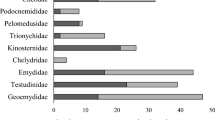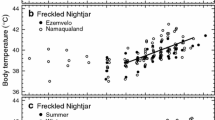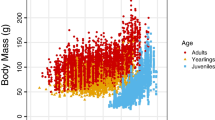Abstract
Aestivation, which in the context of this paper refers to avian and mammalian torpor in summer/at high ambient temperatures (T a), does not appear to differ functionally from other forms of torpor, and to a large extent reflects the higher body temperatures (T b) caused by high T a. However, from an ecological point of view, aestivation results in different challenges and requirements than does torpor use in winter, because heat can cause reduced food and water availability in many regions, but without the access to low T a for a substantial reduction of T b. Aestivation is used by a diversity of adult mammals and birds both in the field and laboratory, as well as by growing young to reduce thermoregulatory energy expenditure. Torpor occurs at high T a including the thermo-neutral zone and even under these conditions the reduction in energy expenditure and water requirements or water loss is substantial. Although data from the laboratory and, especially, from the field are limited, they show that torpor at high T a is an effective survival strategy and suggest that it is employed by many mammals and birds in a diversity of habitats.
Similar content being viewed by others
References
Bae HH, Larkin JE, Zucker I (2003) Juvenile Siberian hamsters display torpor and modified locomotor activity and body temperature rhythms in response to reduced food availability. Physiol Biochem Zool 76:858–867
Barnes BM (1989) Freeze avoidance in a mammal: body temperatures below 0°C in an Arctic hibernator. Science 244:1593–1595
Barnes BM (1996) Relationship between hibernation and reproduction in male ground squirrels. In: Geiser F, Hulbert AJ, Nicol S (eds) Adaptations to the cold. University of New England Press, Armidale, pp 71–80
Bartels W, Law BS, Geiser F (1998) Daily torpor and energetics in a tropical mammal, the northern blossom-bat Macroglossus minimus (Megachiroptera). J Comp Physiol B 168:233–239
Bieber C, Ruf T (2009) Summer dormancy in edible dormice (Glis glis) without energetic constraints. Naturwissenschaften 96:65–171
Bladon RV, Dickman CR, Hume ID (2002) Effect of habitat fragmentation on the demography, movements and social organization of the eastern pygmy-possums (Cercartetus nanus) in northern New South Wales. Wildl Res 29:105–116
Boersma PD (1986) Body temperature, torpor, and growth in chicks of fork-tailed strom-petrels (Oceanodroma furcata). Physiol Zool 59:10–19
Boyer BB, Barnes BM (1999) Molecular and metabolic aspects of mammalian hibernation. Bioscience 49:713–724
Bozinovic F, Rosenmann M (1988) Daily torpor in Calomys musculinus, a South American rodent. J Mammal 69:150–152
Brice PH, Grigg GC, Beard LA, Donovan JA (2002) Patterns of activity and inactivity in echidnas (Tachyglossus aculeatus) free-ranging in a hot dry climate: correlates with ambient temperature, time of day and season. Aust J Zool 50:461–475
Brigham RM (1992) Daily torpor in a free-ranging goatsucker, the common poorwill (Phalaenoptilus nuttallii). Physiol Zool 65:457–472
Buffenstein R (1985) The effect of starvation, food restriction, and water deprivation on thermoregulation and average daily metabolic rates in Gerbillus pusillus. Physiol Zool 58:320–328
Carey HV, Andrews MT, Martin SL (2003) Mammalian hibernation: cellular and molecular responses to depressed metabolism and low temperature. Physiol Rev 83:1153–1181
Carpenter FL (1974) Torpor in an Andean hummingbird: its ecological significance. Science 183:545–547
Carpenter FL, Hixon MA (1988) A new function of torpor: fat conservation in a wild migrant hummingbird. Condor 90:373–378
Chruszcz BJ, Barclay RMR (2002) Thermoregulatory ecology of a solitary bat, Myotis evotis, roosting in rock crevices. Funct Ecol 16:18–26
Coburn DK, Geiser F (1998) Seasonal changes in energetics and torpor patterns in the sub-tropical blossom-bat Syconycteris australis (Megachiroptera). Oecologia 113:467–473
Collins BG, Wooller RD, Richardson KC (1987) Torpor by the honey possum, Tarsipes rostratus (Marsupialia: Tarsipedidae), in response to food intake and low environmental temperature. Aust Mammal 11:51–57
Cooper CE, McAllan BM, Geiser F (2005) Effect of torpor on the water economy of an arid-zone marsupial, the striped-faced dunnart (Sminthopsis macroura). J Comp Physiol B 175:323–328
Dausmann KH, Glos J, Ganzhorn JU, Heldmaier G (2005) Hibernation in the tropics: lessons from a primate. J Comp Physiol B 175:147–155
Dawson WR, Fisher CD (1969) Responses to temperature by the spotted nightjar (Eurostopodus guttatus). Condor 71:49–53
Dietz M, Kalko EKV (2006) Seasonal changes in daily torpor patterns of free-ranging female and male Daubenton’s bats (Myotis daubentonii). J Comp Physiol B 176:223–231
Downs CT, Brown M (2002) Nocturnal heterothermy and torpor in the Malachite sunbird (Nectarinia famosa). Auk 119:251–260
Fietz J, Tataruch F, Dausmann KH, Ganzhorn JU (2003) White adipose tissue composition in the free-ranging fat-tailed dwarf lemur (Cheirogaleus medius; Primates), a tropical hibernator. J Comp Physiol B 173:1–10
Finke C, Misovic A, Prinzinger R (1995) Growth, the development of endothermy, and torpidity in blue-naped mousebirds Urocolius macrourus. Ostrich 66:1–9
Florant GL, Heller HC (1977) CNS regulation of body temperature in euthermic and hibernating marmots (Marmota flaviventris). Am J Physiol 232:R203–R208
French AR (1985) Allometries of the duration of torpid and euthermic intervals during mammalian hibernation: a test of the theory of metabolic control of the timing of changes in body temperature. J Comp Physiol B 156:13–19
French AR (2008) Patterns of heterothermy in rodents. In: Lovegrove BG, McKechnie AE (eds). Hypometabolism in animals: torpor, hibernation and cryobiology. Presented in 13th international hibernation symposium. University of KwaZulu-Natal, Pietermaritzburg. pp. 337–352
Geiser F (1988) Daily torpor and thermoregulation in Antechinus (Marsupialia): influence of body mass, season, development, reproduction, and sex. Oecologia 77:395–399
Geiser F (1998) Evolution of daily torpor and hibernation in birds and mammals: Importance of body size. Clin Exp Pharmacol Physiol 25:736–740
Geiser F (2003) Thermal biology and energetics of carnivorous marsupials. In: Jones M, Dickman C, Archer M (eds) Predators with pouches: the biology of carnivorous marsupials. CSIRO, Melbourne, pp 234–249
Geiser F (2004) Metabolic rate and body temperature reduction during hibernation and daily torpor. Annu Rev Physiol 66:239–274
Geiser F (2007) Yearlong hibernation in a marsupial mammal. Naturwissenschaften 94:941–944
Geiser F (2008) Ontogeny and phylogeny of endothermy and torpor in mammals and birds. Comp Biochem Physiol A 150:176–180
Geiser F, Baudinette RV (1987) Seasonality of torpor and thermoregulation in three dasyurid marsupials. J Comp Physiol B 157:335–344
Geiser F, Kenagy GJ (1988) Torpor duration in relation to temperature and metabolism in hibernating ground squirrels. Physiol Zool 61:442–449
Geiser F, Masters P (1994) Torpor in relation to reproduction in the Mulgara, Dasycercus cristicauda (Dasyuridae: Marsupialia). J Therm Biol 19:33–40
Geiser F, Ruf T (1995) Hibernation versus daily torpor in mammals and birds: physiological variables and classification of torpor patterns. Physiol Zool 68:935–966
Geiser F, Brigham RM (2000) Torpor, thermal biology, and energetics in Australian long-eared bats (Nyctophilus). J Comp Physiol B 170:153–162
Geiser F, Körtner G (2004) Thermal biology, energetics, and torpor in the possums and gliders. In: Goldingay RL, Jackson SM (eds) The biology of Australian possums and gliders. Surrey Beatty, Sydney, pp 186–198
Geiser F, Körtner G (2009) Hibernation and daily torpor in Australian mammals. Aust Zool, in press
Geiser F, Körtner G, Schmidt I (1998) Leptin increases energy expenditure of a marsupial by inhibition of daily torpor. Am J Physiol 275:R1627–R1632
Geiser F, Westman W, McAllan BM, Brigham RM (2006) Development of thermoregulation and torpor in a marsupial: energetic and evolutionary implications. J Comp Physiol B 176:107–116
Geiser F, Goodship N, Pavey CR (2002) Was basking important in the evolution of mammalian endothermy? Naturwissenschaften 89:412–414
Geiser F, Drury RL, Körtner G, Turbill C, Pavey CR, Brigham RM (2004) Passive rewarming from torpor in mammals and birds: energetic, ecological and evolutionary implications. In: Barnes BM, Carey HV (eds) Life in the cold: evolution, mechanisms, adaptation, and application, vol 27. Institute of Arctic Biology, University of Alaska, Fairbanks, pp 51–62
Grigg GC, Beard LA, Augee ML (2004) The evolution of endothermy and its diversity in mammals and birds. Physiol Biochem Zool 77:982–997
Giroud S, Perret M, LeMaho Y, Momken I, Gilbert C, Blanc S (2009) Gut hormones in relation to body mass and torpor pattern changes during food restriction and re-feeding in the gray mouse lemur. J Comp Physiol B 179:99–111
Guppy M, Withers PC (1999) Metabolic depression in animals: physiological perspectives and biochemical generalizations. Biol Rev 74:1–40
Gutman R, Choshniak I, Kronfeld-Schor N (2006) Defending body mass during food restriction in Acomys russatus: a desert rodent that does not store food. Am J Physiol 290:R881–R891
Hall M (1832) On hybernation. Trans Roy Soc London B 122:335–360
Harlow HJ (1981) Torpor and other physiological adaptations of the badger (Taxidea taxus) to cold environments. Physiol Zool 54:267–275
Heldmaier G, Steinlechner S (1981) Seasonal pattern and energetics of short daily torpor in the Djungarian hamster, Phodopus sungorus. Oecologia 48:265–270
Hiebert SM (1993) Seasonality of daily torpor in a migratory hummingbird. In: Carey C, Florant GL, Wunder BA, Horwitz B (eds) Life in the cold: ecological, physiological, and molecular mechanisms. Westview, Boulder, pp 25–32
Hock RJ (1951) The metabolic rates and body temperatures of hibernating bats. Biol Bull 101:289–299
Holloway JC, Geiser F (1995) Influence of torpor on daily energy expenditure of the dasyurid marsupial Sminthopsis crassicaudata. Comp Biochem Physiol A 112(1):59–66
Holloway JC, Geiser F (1996) Reproductive status and torpor of the marsupial Sminthopsis crassicaudata: effect of photoperiod. J Therm Biol 21:373–380
Hollis L, Barclay RMR (2008) Developmental changes in body temperature and use of torpor by the big brown bat (Eptesicus fuscus). In: Lovegrove BG, McKechnie AE (eds) Hypometabolism in animals: torpor, hibernation and cryobiology. University of KwaZulu-Natal, Pietermaritzburg, pp 361–372
Hudson JW, Bartholomew GA (1964) Terrestrial animals in dry heat: estivators. In: Dill DB (ed) Adaptation to the environment. Am Physiol Soc, Washington, pp 541–550
Hulbert AJ, Else PL (1989) Evolution of mammalian endothermic metabolism: mitochondrial activity and cell composition. Am J Physiol 256:R63–R69
Kennedy PM, MacFarlane WV (1971) Oxygen consumption and water turnover of the fat-tailed marsupials Dasycercus cristicauda and Sminthopsis crassicaudata. Comp Biochem Physiol A 40:723–732
Kissner KJ, Brigham RM (1993) Evidence for the use of torpor by incubating and brooding common poorwills Phalaenoptilus nuttallii. Ornis Scand 24:333–334
Koskimies J (1948) On temperature regulation and metabolism in the swift, Micropus a. apus L. during fasting. Experientia 4:274–276
Körtner G, Geiser F (2000) The temporal organization of daily torpor and hibernation: circadian and circannual rhythms. Chronobiol Int 17:103–128
Körtner G, Geiser F (2009) The key to winter survival: daily torpor in a small arid zone marsupial. Naturwissenschaften 95:525–530
Körtner G, Brigham RM, Geiser F (2000) Winter torpor in a large bird. Nature 407:318
Körtner G, Pavey CR, Geiser F (2008) Thermal biology, torpor and activity in free-living mulgaras in arid zone Australia during the winter reproductive season. Physiol Biochem Zool 81:442–451
Lawrence E (ed) (2008) Henderson’s dictionary of biology. Pearson, Harlow, UK
Lovegrove BG, Raman J (1998) Torpor patterns in the pouched mouse (Saccostomus campestris; Rodentia): a model animal for unpredictable environments. J Comp Physiol B 168:303–312
Lovegrove BG, Génin F (2008) Torpor and hibernation in a basal placental mammal, the lesser hedgehog tenrec (Echinops telfairi). J Comp Physiol B 178:691–698
Lovegrove BG, Körtner G, Geiser F (1999) The energetic cost of arousal from torpor in the marsupial Sminthopsis macroura: benefits of summer ambient temperature cycles. J Comp Physiol B 169:11–18
Lyman CP, Willis JS, Malan A, Wang LCH (1982) Hibernation and torpor in mammals and birds. Academic, New York
MacMillen RE (1965) Aestivation in the cactus mouse Peromyscus eremicus. Comp Biochem Physiol 16:227–247
MacMillen RE, Trost CH (1967) Nocturnal hypothermia in the Inca dove Scardafella inca. Comp Biochem Physiol 23:243–252
McKechnie AE, Lovegrove BG (2002) Avian facultative hypothermic responses: a review. Condor 104:705–724
Nagel A (1977) Torpor in the European white-toothed shrews. Experientia 33:1454–1456
Nicol SC, Andersen NA (2007) The life history of an egg-laying mammal, the echidna (Tachyglossus aculeatus). Ecoscience 14:275–285
Nicol SC, Morrow G, Andersen NA (2008) Hibernation in monotremes: a review. In: Lovegrove BG, McKechnie AE (eds) Hypometabolism in animals: torpor, hibernation, and cryobiology. University of KwaZulu-Natal, Pietermaritzburg, pp 251–262
Pough FH, Janis CM, Heiser JB (2009) Vertebrate life. Pearson, San Francisco
Prinzinger R, Siedle K (1988) Ontogeny of metabolism, thermoregulation and torpor in the house martin Delichon u. urbica (L.) and its ecological significance. Oecologia 76:307–312
Ruf T, Klingenspor M, Preis H, Heldmaier G (1991) Daily torpor in the Djungarian hamster (Phodopus sungorus): interactions with food intake, activity, and social behaviour. J Comp Physiol B 160:609–615
Schmid J, Speakman JR (2000) Daily energy expenditure of the grey mouse lemus (Microcebus murinus): a small primate that uses torpor. J Comp Physiol B 170:633–641
Schleucher E (2001) Heterothermia in pigeons and doves reduces energetic costs. J Therm Biol 26:287–293
Song X, Geiser F (1997) Daily torpor and energy expenditure in Sminthopsis macroura: interactions between food and water availability and temperature. Physiol Zool 70:331–337
Song X, Körtner G, Geiser F (1995) Reduction of metabolic rate and thermoregulation during daily torpor. J Comp Physiol B 165:291–297
Song X, Körtner G, Geiser F (1997) Thermal relations of metabolic rate reduction in a hibernating marsupial. Am J Physiol 273:R2097–R2104
Stawski C, Turbill C, Geiser F (2008) Summer torpor in a subtropical insectivorous bat. Proc Aust New Zeal Soc Comp Physiol Biochem 25:57
Stawski C, Turbill C, Geiser F (2009) Hibernation by a free-ranging subtropical bat (Nyctophilus bifax). J Comp Physiol B 179:433–441
Storey KB, Storey JM (1990) Metabolic rate depression and biochemical adaptation in anaerobiosis, hibernation and estivation. Q Rev Biol 65:145–174
Studier EH (1981) Energetic advantages of slight drops in body temperature in little brown bats, Myotis lucifugus. Comp Biochem Physiol A 70:537–540
Turbill C, Geiser F (2008) Hibernation by tree-roosting bats. J Comp Physiol B 178:597–605
Turbill C, Law BS, Geiser F (2003a) Summer torpor in a free-ranging bat from sub-tropical Australia. J Therm Biol 28:223–226
Turbill C, Körtner G, Geiser F (2003b) Natural use of torpor by a small, tree-roosting bat during summer. Physiol Biochem Zool 76:868–876
Turbill C, Körtner G, Geiser F (2008) Timing of the daily temperature cycle affects the critical arousal temperature and energy expenditure of the lesser long-eared bat. J Exp Biol 211:3871–3878
Vivier L, van der Merwe M (2007) The incidence of torpor in winter and summer in the Angolan free-tailed bat, Mops condylurus (Microchiroptera: Molossidae), in a subtropical environment, Mpumulanga, South Africa. Afr Zool 42:50–58
Wang LCH (1978) Energetics and field aspects of mammalian torpor: the Richardsons’s ground squirrel. In: Wang LCH, Hudson JW (eds) Strategies in cold. Academic, New York, pp 109–145
Warnecke L, Turner JM, Geiser F (2008) Torpor and basking in a small arid zone marsupial. Naturwissenschaften 95:73–78
Webb PI, Skinner JD (1996) Summer torpor in African woodland dormice Graphiurus murinus (Myoxidae: Graphiurinae). J Comp Physiol B 166:325–330
Willis CKR, Turbill C, Geiser F (2005) Torpor and thermal energetics in a tiny Australian vespertilionid, the little forest bat (Vespadelus vulturnus). J Comp Physiol B 175:479–486
Willis CKR, Brigham RM, Geiser F (2006) Deep, prolonged torpor by pregnant, free-ranging bats. Naturwissenschaften 93:80–83
Wilz M, Heldmaier G (2000) Comparison of hibernation, estivation and daily torpor in the edible dormouse, Glis glis. J Comp Physiol B 170:511–521
Withers PC (1977) Respiration, metabolism, and heat exchange of euthermic and torpid poorwills and hummingbirds. Physiol Zool 50:43–52
Withers PC (1992) Comparative animal physiology. Saunders, Fort Worth
Withers PC, Cooper CE (2009) Metabolic depression: a historical perspective. This volume
Withers PC, Richardson KC, Wooller RD (1990) Metabolic physiology of euthermic and torpid honey possums, Tarsipes rostratus. Aust J Zool 37:685–693
Woods CP, Brigham RM (2004) The avian enigma: “Hibernation” by common poorwills (Phalaenoptilus nuttallii). In: Barnes BM, Carey HV (eds) Life in the cold: evolution, mechanisms, adaptation, and application, vol 27. Institute of Arctic Biology, University of Alaska, Fairbanks, pp 231–240
Zervanos SM, Salsbury CM (2003) Seasonal body temperature fluctations and energetic strategies in free-ranging eastern woodchucks (Marmota monax). J Mammal 84:299–310
Acknowledgments
The author would like to thank Gerhard Körtner, Bronwyn McAllan, and Phil Withers for constructive comments on the manuscript. The Australian Research Council supported the work
Author information
Authors and Affiliations
Corresponding author
Editor information
Editors and Affiliations
Rights and permissions
Copyright information
© 2010 Springer-Verlag Berlin Heidelberg
About this chapter
Cite this chapter
Geiser, F. (2010). Aestivation in Mammals and Birds. In: Arturo Navas, C., Carvalho, J. (eds) Aestivation. Progress in Molecular and Subcellular Biology, vol 49. Springer, Berlin, Heidelberg. https://doi.org/10.1007/978-3-642-02421-4_5
Download citation
DOI: https://doi.org/10.1007/978-3-642-02421-4_5
Published:
Publisher Name: Springer, Berlin, Heidelberg
Print ISBN: 978-3-642-02420-7
Online ISBN: 978-3-642-02421-4
eBook Packages: Biomedical and Life SciencesBiomedical and Life Sciences (R0)




